In the dance between wind and water, our trolling motor serves as the lead, guiding us to our desired path. We all know that having it positioned just right can mean the difference between a smooth journey and a turbulent ride. Let's explore how understanding our boat's dynamics, adjusting motor height, and refining our steering techniques can help us reveal peak performance. As we focus on maximizing our efficiency, there's a blend of strategy and innovation waiting to be uncovered. How, then, do we truly harness these elements for a perfect experience on the water?
Understanding Boat Dynamics
When it comes to understanding boat dynamics, let's plunge into the forces that act on a boat, shaping its movement and behavior. Our journey starts with hydrodynamic forces and aerodynamic balance, vital elements every boating enthusiast should grasp. Hydrodynamic forces are like the secret currents that keep our vessel gliding smoothly or slow us down. The friction between the boat's hull and water creates hydrodynamic drag, which tries to stop our forward progress. But don't worry, there's also lift helping us out, thanks to the hull's shape and speed. A keel helps a sailboat move in its intended direction, preventing unintended downwind drifting. For aerodynamic balance, the sails play a starring role. They generate lift from the wind, pushing us forward, while aerodynamic drag, that pesky air resistance, tries to hold us back. The secret to conquering these is in how we set our sails – their angle and shape can make a world of difference.
As we navigate, the perfect harmony between aerodynamic and hydrodynamic forces is vital. It's like a dance on water, deciding whether we sail freely or struggle against resistance. By understanding these forces, we can master the art of efficient sailing, gaining the freedom to explore with ease.
Ideal Mounting Location
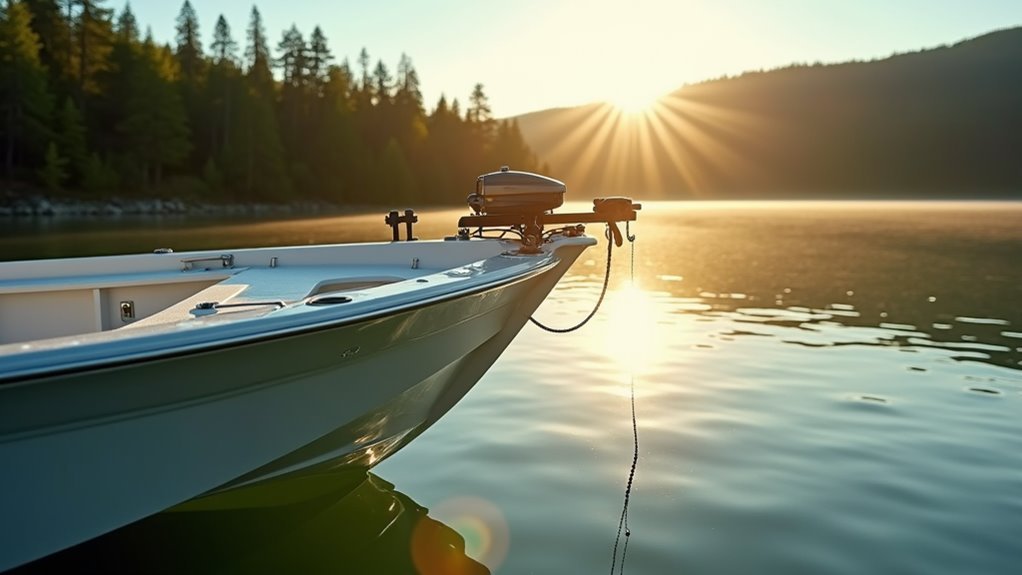
A trolling motor's ideal mounting location can substantially enhance our boating experience, much like placing a key perfectly in a lock guarantees smooth operation. When selecting the perfect spot, we need to ponder bow clearance. This guarantees our motor moves freely, unobstructed by obstacles. It is important to note that bow-mounted trolling motors are particularly suited for boats with level bows and no rail. An ideal choice for many fishing boats is bow mounting, especially when the bow is flat and open. It's vital we avoid cluttering deck space where we'll need free movement.
Rail adjustment becomes imperative, especially when the bow rail could potentially interfere with our motor. Adjusting or even cutting a section might be necessary. But don't worry; we can use a sleeve to bridge any gaps, maintaining a smooth motor deployment.
Remember the motor doesn't need to be perfectly centered—port or starboard mounting may work better, especially on boats with bow tip platforms.
Finally, think about our deck layout so when it's time for action, our motor isn't in the way of casting or blocking the driver's view. Planning power cable routes is also key to avoid messy tangles, securing our freedom on the water without interruption.
Adjusting Motor Height
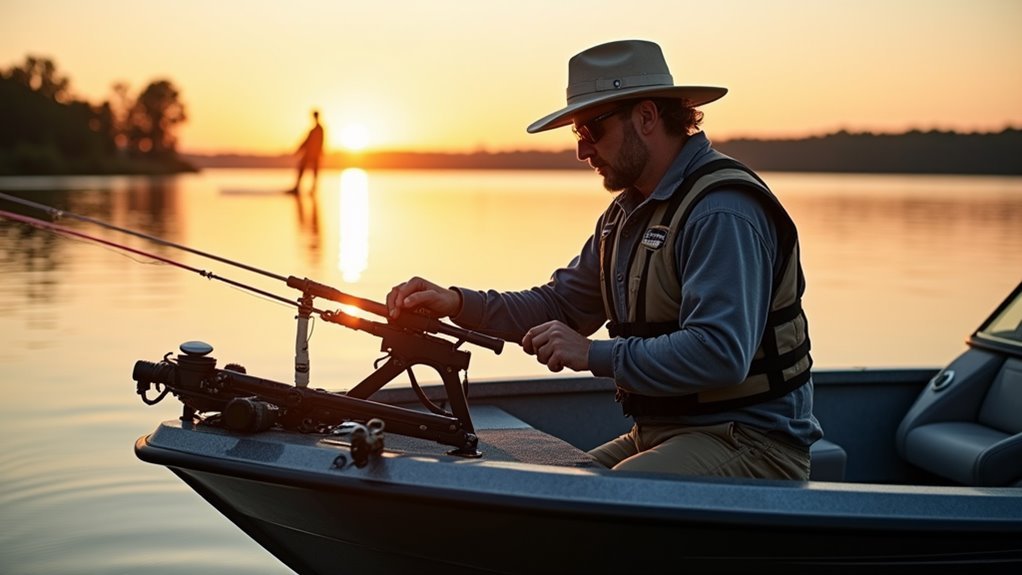
Adjusting the height of our trolling motor is crucial for optimizing boat performance and efficiency. By carefully managing motor alignment and depth calibration, we can navigate through various water conditions with greater freedom and confidence.
Here's how we can get it just right:
- Use the Depth Adjustment Mechanism: At the base of our steering system housing, we can find the collar used for depth adjustment. Loosen it, set the desired motor height, then securely tighten it. Quick and simple!
- Mind the Cables: As we adjust the height, we need to verify that the coiled cable isn't compressed. This prevents damage and allows our motor to pivot smoothly. Ensuring the coiled cable is free from tangles or damage enhances the motor's ability to operate efficiently.
- Lift Assist and Thumb Screw: If our trolling motor has a lift assist, let's use it to easily raise and lower our motor. Tighten with the thumb screw for a secure fit.
With these steps, we're well-equipped to handle challenging wave conditions by raising the motor, or avoid propeller clogs in weedy areas.
Consistent depth checks verify our motor operates effectively, and thorough cable management keeps troubles at bay.
This gives us the freedom to explore with confidence, knowing our equipment will perform as expected.
Steering Techniques
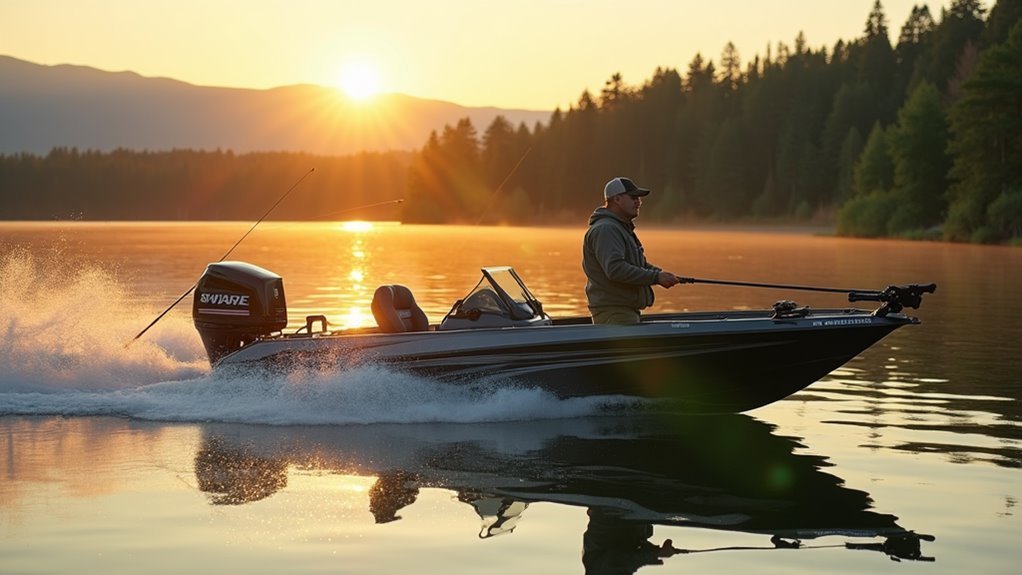
Steering our trolling motor is an essential skill for traversing waters with precision and ease. Whether we're using tiller adjustments or fine-tuning pedal calibration, mastering these techniques opens up a world of freedom on the water.
Tiller steer controls, similar to those on small outboards, feel intuitive: turning the tiller clockwise speeds us up, while counter-clockwise slows us down. To steer, we push the tiller left to turn right, and right to turn left. With some practice, we'll glide over lakes and rivers with ease.
For those who prefer their hands free, foot pedal motors offer an exciting alternative. By rocking the pedal forward or backward, we can steer our vessel without letting go of the fishing rod.
The pressure we apply controls both direction and speed, making pedal calibration key. Different brands might've unique systems, but with an afternoon on the water, we'll become pros.
And let's not forget wireless steering options, which bring precision and convenience. By installing wireless servo kits, controlling our motor becomes a breeze. Servo steering systems are used in various applications, like remote-controlled vehicles, where precise control and smooth transitions are essential. These kits allow us to maneuver smoothly, giving us even more freedom to explore and enjoy the water's expanse.
Battery Management Strategies
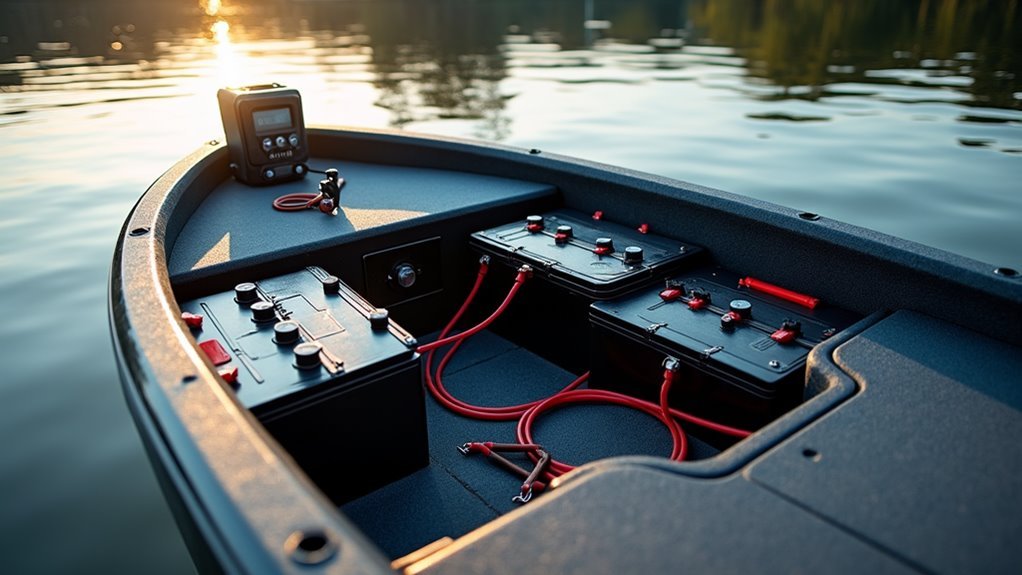
When we're traversing the waters with a trolling motor, effective battery management is essential to maintaining peak performance and longevity. To keep our adventures powered and smooth, we need to focus on a few key strategies.
By managing how our battery connects with our motor, we extend both its life and efficiency.
Let's delve into three essential strategies for battery management:
- Battery Monitoring: To preserve our battery's capacity and internal health, we should always use a battery monitor. It keeps us updated on age, capacity, and internal resistance, ensuring that we aren't caught off guard by surprise battery failures.
- Charge Optimization: Immediately after every outing, recharging our batteries helps prevent lead sulfate build-up, which can harm performance. For ideal upkeep during the off-season, employing a trickle charger or regular monthly recharges keeps our battery primed.
- General Battery Care: It's important to store batteries in cool, dry places and handle them carefully according to type. Regular maintenance, like removing any corrosion and securing clean connections, is critical for steady motor function. By following these maintenance practices, we can avoid deep discharging which helps prolong the battery's lifespan.
Together, these strategies grant us the freedom to explore open waters confidently and without worry, leaving us only to chase after new adventures.
Dealing With Wind and Currents
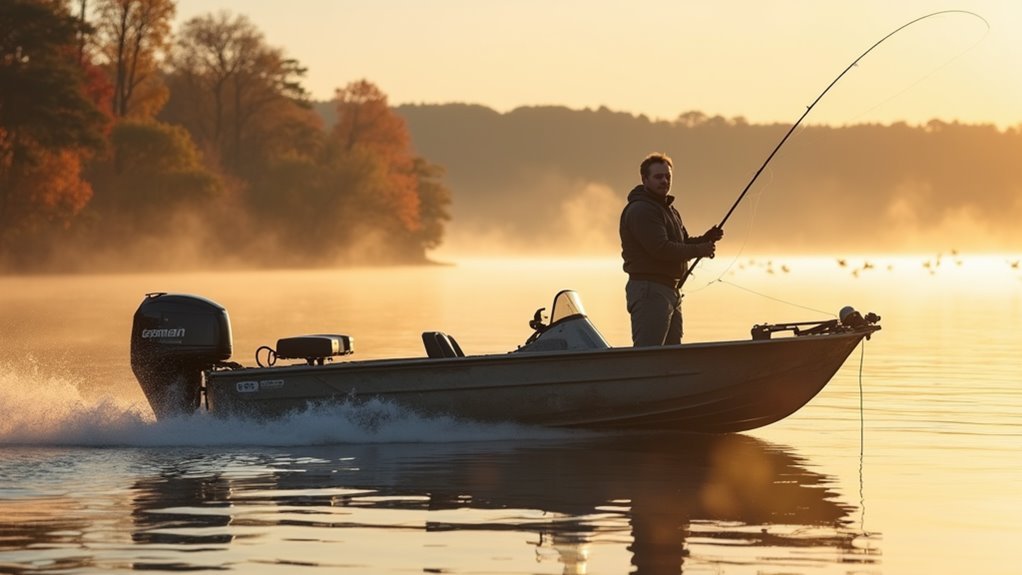
Traversing through the complexities of wind and currents requires both strategy and skill. As we set out on our fishing adventures, balancing wind compensation and current mitigation is vital for success.
Imagine controlling our boat seamlessly, even when nature conspires against us. The key lies in having enough thrust; it's like having powerful muscles to push through those gusty winds and swirling currents. Thrust levels should match the wind's intensity and the current's speed. Our boat's design and weight also play a role in how much power we need.
With smart trolling motor features, managing these forces becomes a fascinating game. The autopilot gives precise control, adjusting our boat's heading and speed as if on a whim. Manufacturers design trolling motors to withstand the harsh saltwater environment, making them reliable even during challenging conditions. Meanwhile, the jog feature lets us make tiny tweaks to our position without too much fuss, ensuring our spot is just right.
When starting a drift, bringing the boat to a stop aligns us perfectly with the wind or current, setting the stage for a smooth ride. By understanding how these elements affect our journey, we can conquer the waters with confidence and ease. Let's embrace the wild, riding the waves on our terms.
Utilizing GPS Features
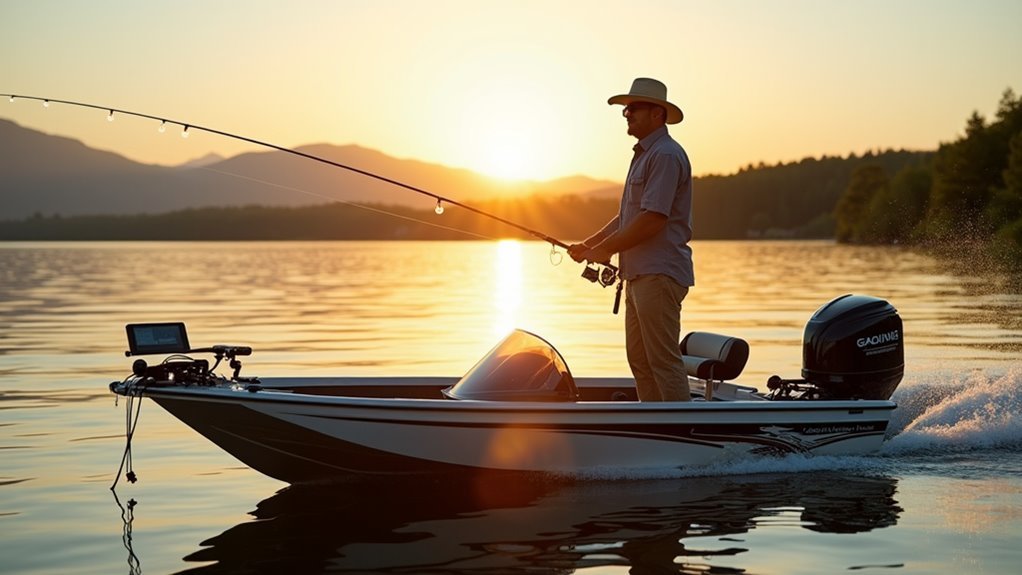
Harnessing the power of advanced GPS features turns the fishing experience into a technological marvel. With GPS calibration, we guarantee our trolling motors have peak performance, guiding us straight to our favorite fishing spots. A key aspect of this innovation is the automatic adjustment for environmental conditions, which ensures the boat remains stable even with wind and waves. By focusing on signal optimization, we maintain a strong signal, which is vital for precise movements on the water. We've discovered that knowing how to use these features frees us to explore without worry.
Advanced GPS features offer several practical tools:
- Virtual Anchor: This feature holds us steady using GPS as if we're anchored in place, letting us focus on fishing.
- Track Mode: Our boat can automatically follow a set course, adjusting for wind and currents, so we don't have to constantly steer.
- Memory Locations: We can save the best spots, guaranteeing we return later with pinpoint accuracy.
These features are more than gadgets; they're gateways to new fishing adventures. While out on the water, understanding and utilizing GPS technology elevates our experience.
Fine-Tuning Speed Control
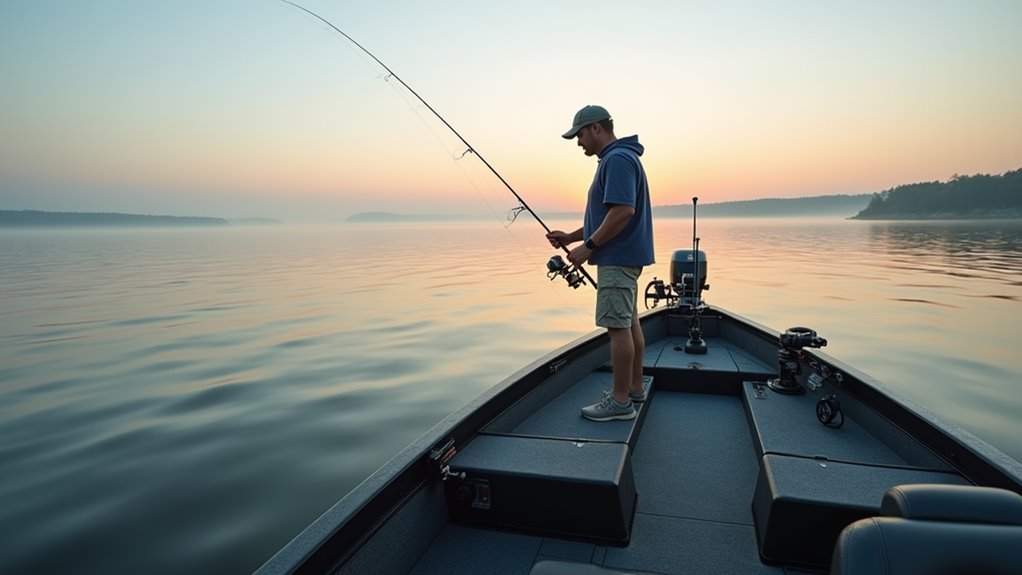
Fine-tuning speed control on our trolling motor can substantially enhance our fishing experience and efficiency. By optimizing the way we manage speed, we gain the freedom to navigate waters precisely and conserve our battery life even more effectively.
Incorporating PWM devices is one great way to achieve this. These devices allow us to convert fixed-speed motors into variable-speed engines, giving us better control over the speed settings. Imagine being able to adjust our pace smoothly as we glide towards that perfect fishing spot! By using a switch and knob for variable speed control, we can set the desired speed with precision, adding much-needed convenience and effectiveness.
We've got the option of installing custom controllers too. These controllers offer more flexibility over our speed settings, letting us tailor the motor's performance to meet our specific needs. With custom controllers, we're not stuck with pre-set levels and can find that sweet spot that suits our fishing style best.
If we're looking for even simpler solutions, swapping our trolling motor's propeller for one with a lower pitch or smaller diameter can be a game-changer. This tweak can effectively slow our boat without altering any motor components. By making these adjustments, we'll enjoy more time fishing and less time fiddling with settings, truly embracing the freedom of the open water.
Regular Maintenance Tips
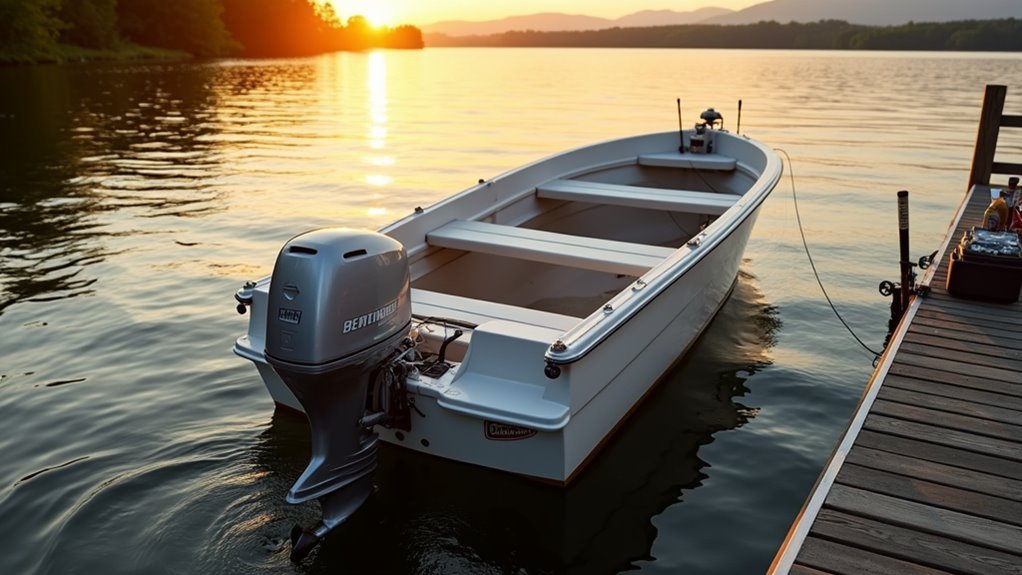
As we initiate the regular maintenance of our trolling motors, keeping them in top shape is essential for peak performance and longevity. Regular care not only guarantees our gear remains reliable but also lets us enjoy our adventures with fewer worries.
Here's how we can make the most of our maintenance routine:
- Cable Inspection: It's important to check power cables for any wear. Patch or repair them as necessary to prevent unexpected power loss while out on the water.
- Terminal Cleaning: Clean power terminals regularly to make sure our connections are strong and efficient, reducing potential power issues.
- Propeller Maintenance: Consistently inspect the propeller for any damage or bent blades, as damaged propellers can significantly reduce motor efficiency and performance.
- Post-Use Care: After every outing in saltwater, rinse the motor with fresh water. This simple step can prevent corrosion and extend the life of our equipment.
Moreover, let's not forget to tighten mounting bolts, lubricate vital parts, and regularly wash away grime.
Applying a water-based silicone spray keeps things running smoothly, while guaranteeing hinges and latches move without a hitch.
Regular cable inspections and managing battery connections are quick checks that maximize our motor's reliability.
Frequently Asked Questions
How Do I Troubleshoot a Non-Responsive Trolling Motor?
We troubleshoot a non-responsive trolling motor by checking battery connections and voltage, inspecting wiring for issues, and conducting motor diagnostics. Let's guarantee every component functions seamlessly so we're free to explore the open waters without hassle.
Can I Use a Trolling Motor in Saltwater Without Modifications?
Imagine traversing a labyrinth with blindfolds; using a freshwater motor in saltwater is comparable. Without modifications for saltwater compatibility and sufficient corrosion protection, we risk damage. Ensuring freedom on open waters requires preparing our equipment properly.
What Are Safety Tips for Operating a Trolling Motor?
Let's guarantee our trolling motor adventure is safe and smooth. We'll prioritize regular battery maintenance and propeller inspection. This empowers us to explore freely, knowing our equipment's reliable and ready for changing waters and unexpected challenges.
How Does Trolling Motor Noise Affect Fishing Success?
Like whispering winds in a meadow, our trolling motor's sound waves weave into water, subtly influencing fish behavior. Let's master this symphony to enhance our fishing success, ensuring both nature's harmony and our freedom to explore remain undisturbed.
Are There Legal Considerations for Trolling Motor Use in Different Areas?
We must stay informed about regulatory compliance to enjoy our freedom with trolling motors. Understanding how laws vary helps us reduce environmental impact while ensuring we're fishing legally and ethically in diverse areas. Let's respect nature and explore responsibly.
Conclusion
Let's picture it: we're gliding smoothly across the water, our trolling motor purring effortlessly. By positioning it just right, adjusting for the breeze, and keeping up with maintenance, we've turned our boat into a finely tuned machine. With each tweak and adjustment, we uncover the secrets to peak performance, feeling confident and in control. Remember, the open water is our adventure, and with these tips, we're ready to make the most of it. Happy boating!